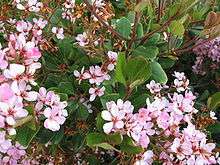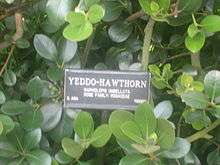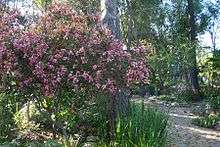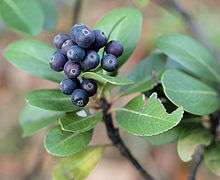Rhaphiolepis
| Rhaphiolepis | |
|---|---|
 | |
| Rhaphiolepis indica in flower | |
| Scientific classification | |
| Kingdom: | Plantae |
| (unranked): | Angiosperms |
| (unranked): | Eudicots |
| (unranked): | Rosids |
| Order: | Rosales |
| Family: | Rosaceae |
| Subfamily: | Amygdaloideae[1] |
| Tribe: | Maleae |
| Subtribe: | Malinae |
| Genus: | Rhaphiolepis Lindl. |
| Species | |
|
About fifteen species, including: | |
Rhaphiolepis (/ˌræfiˈɒlᵻpɪs/ or /ˌræfioʊˈlɛpᵻs/;[2]) is a genus of about fifteen species of evergreen shrubs and small trees in the family Rosaceae, native to warm temperate and subtropical eastern and southeastern Asia, from southern Japan, southern Korea and southern China south to Thailand and Vietnam. In searching literature it is well to remember that the name commonly is misspelt "Raphiolepsis". The genus is closely related to Eriobotrya (loquats), so closely in fact, that members of the two genera have hybridised with each other; for example the "Coppertone loquat" is a hybrid of Eriobotrya deflexa X Rhaphiolepis indica. The common name hawthorn, originally specifically applied to the related genus Crataegus, now also appears in the common names for some Rhaphiolepis species. For example, Rhaphiolepis indica often is called "Indian hawthorn", and Rhaphiolepis umbellata, "Yeddo hawthorn".
The species vary in size, some only reaching 1–1.5 m (3 ft 3 in–4 ft 11 in), while R. ferruginea can reach 10 m (33 ft). The leaves are alternate, leathery, glossy dark green, simple, 3–9 cm (1.2–3.5 in) long, with an entire or serrated margin. The flowers are white or pink, 1–2 cm (0.39–0.79 in) diameter, produced in small to large corymbs. The fruit is a small pome 1–2 cm (0.39–0.79 in) diameter, ripening dark purple to black, usually containing only a single seed.
Cultivation and uses

The best known species is Rhaphiolepis indica (Indian hawthorn) from southern China, grown for its decorative pink flowers, and popular in bonsai culture. Rhaphiolepis umbellata (Yeddo hawthorn) from Japan and Korea has blunter leaves and white flowers. It is the hardiest species, tolerating temperatures down to about −15 °C (5 °F).
The fruit of some varieties is edible when cooked, and can be used to make jam, but some ornamental varieties bear fruit that is of no culinary value.


Indian Hawthorn is a mainstay horticultural specimen in southern United States. It is often found in commercial as well as in private landscapes. Often it is trimmed into small compact hedges or balls for foundation plants. It has been successfully pruned into a standard form as well as small dwarf-like trees up to 15 feet (4.6 m) in height.
The use of Rhaphiolepis in landscapes in humid regions is limited by the susceptibility of many of its species and hybrids to a disfiguring leaf spot disease caused by fungi in the genus Entomosporium.
References
- ↑ Potter, D.; Eriksson, T.; Evans, R. C.; Oh, S.; Smedmark, J. E. E.; Morgan, D. R.; Kerr, M.; Robertson, K. R.; et al. (2007). "Phylogeny and classification of Rosaceae". Plant Systematics and Evolution. 266 (1–2): 5–43. doi:10.1007/s00606-007-0539-9. [Referring to the subfamily by the name "Spiraeoideae"]
- ↑ The first pronunciation is that expected for Anglo-Latin; the second is common in nurseries. Sunset Western Garden Book, 1995:606–607. However, William T. Stearn in his book Botanical Latin says "Botanical Latin is essentially a written language, but the scientific names of plants often occur in speech. How they are pronounced really matters little provided they sound pleasant and are understood..."